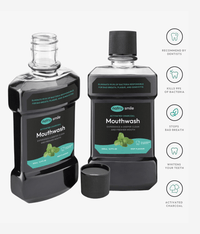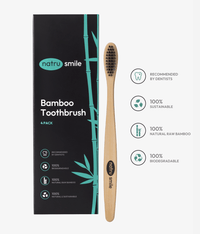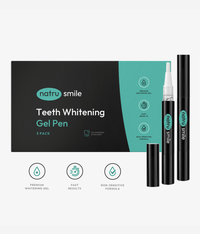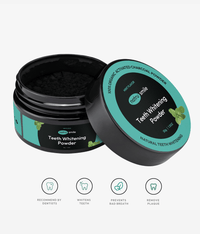
All products are certified by dental expert Dr. Greg Grillo
Welcome to the ultimate guide on rubber bands for braces! If you're seeking a comprehensive understanding of braces and elastics, you've come to the right place. In this article, we will explore the various aspects of rubber bands in orthodontic treatments, including their purpose, functionality, and benefits. Let's get started!
What Are Rubber Bands For Braces? An In-Depth Overview
Rubber bands, also known as elastics for braces, are small, stretchy loops that are attached to braces to help correct dental issues, such as misaligned teeth, bite problems, and jaw position.
These bands play a crucial role in orthodontic treatments; they work in conjunction with your braces to apply the necessary force so that, by the time you are getting braces off, your teeth have moved to the desired position.
Like choosing between metal braces or gold braces, you can also choose between different rubber band colors to match your personal preferences.
Key Functions Of Rubber Bands In Orthodontics:
- Correcting teeth alignment
- Addressing bite problems
- Adjusting jaw position
How Do Rubber Bands Work On Braces? The Science Behind It
Rubber bands on braces apply gentle yet consistent pressure on your teeth, which encourages them to move into their ideal alignment. The elastics are connected to the braces' brackets or hooks, creating a force that works alongside the braces' wires to guide the teeth and jaw into proper alignment.
The Mechanics Of Rubber Bands:
- Connected to brackets or hooks on braces
- Apply consistent pressure on teeth
- Work in tandem with braces' wires
- Gradually move teeth and jaw into proper alignment
Rubber Bands Braces Before And After (Images)
To truly understand the impact of rubber bands on braces, take a look at these before and after images. They showcase the incredible transformation that can be achieved with the help of rubber bands and braces.
Types Of Rubber Bands For Braces: An In-Depth Look
Orthodontic treatment often involves using rubber bands to address various dental issues. These bands, also known as elastics, come in different types, each designed for a specific purpose. In this section, we will delve deeper into the various classes of rubber bands for braces and their applications.
Triangle Rubber Bands
- Purpose: Correct three-point misalignments
- How they work: Triangle elastics connect three brackets, forming a triangular shape to apply pressure and adjust the position of the teeth.
- Common issues addressed: Crowding, rotation, and spacing problems
Class 2 Elastic
- Purpose: Overbite correction
- How they work: Class 2 elastics connect the upper and lower braces, applying pressure to move the lower teeth forward and the upper teeth backward.
- Common issues addressed: Overbites, protruding upper teeth
Class 3 Elastic
- Purpose: Underbite correction
- How they work: Class 3 bands attach the lower braces to the upper ones, creating pressure to move the upper teeth forward and the lower teeth backward.
- Common issues addressed: Underbites, protruding lower teeth
Cross Elastic
- Purpose: Crossbite correction
- How they work: Cross elastics connect brackets diagonally, applying pressure to correct the misalignment of teeth on either side of the mouth.
- Common issues addressed: Crossbites, misaligned teeth
Anterior Elastics
- Purpose: Open bite correction
- How they work: Anterior bands connect the upper and lower front brackets, applying pressure to close the gap between the front teeth.
- Common issues addressed: Open bites, gaps between upper and lower front teeth
Box Rubber Bands
- Purpose: Closing spaces between teeth
- How they work: Box elastics form a box shape around four brackets, applying pressure to close gaps and bring teeth closer together.
- Common issues addressed: Spacing issues, gaps between teeth
Interarch Rubber Bands
- Purpose: Bite alignment
- How they work: Interarch bands connect the upper and lower arches, helping to align the bite and improve overall dental function.
- Common issues addressed: Malocclusion, misaligned bites
Open Bite Elastics
- Purpose: Close open bites
- How they work: Open bite bands connect brackets vertically, applying pressure to bring the upper and lower teeth together.
- Common issues addressed: Open bites, gaps between teeth when biting
Ligature
- Purpose: Secure archwire to brackets
- How they work: Ligature elastics hold the archwire in place by connecting it to the brackets, ensuring proper movement of teeth during treatment.
- Common issues addressed: Maintaining archwire position, adjusting teeth movement
Elastic Separator
- Purpose: Create space between teeth
- How they work: Elastic separators are placed between teeth before braces are applied, creating enough space for bands or other orthodontic appliances.
- Common issues addressed: Tight contacts, preparing teeth for braces
By understanding the different types of rubber bands for braces, you can better appreciate their role in your orthodontic treatment. Your orthodontist will determine the most suitable type of elastics for your specific dental issues and provide guidance on their proper use.
Benefits Of Using Rubber Bands With Braces: A Deeper Dive
Rubber bands, or elastics, are an integral part of orthodontic treatment when used in conjunction with braces. They offer several advantages that contribute to the overall success of the treatment:
Improved Bite Alignment And Function
- Correcting malocclusions, such as overbites, underbites, crossbites, and open bites
- Enhancing the ability to chew and speak properly
- Reducing the risk of developing temporomandibular joint (TMJ) disorders
Enhanced Facial Appearance And Profile
- Boosting self-confidence and self-esteem
- Balancing facial features by improving the relationship between the upper and lower jaws
Faster Treatment Progress
- Accelerating tooth movement when used consistently as directed
- Potentially shortening the overall treatment duration
Customizable To Address Individual Needs
- Available in various types, sizes, and strengths to target specific orthodontic issues
- Allowing for personalized treatment plans based on the patient's unique dental needs
When To Start Wearing Rubber Bands For Braces
The ideal time to begin wearing rubber bands for braces depends on several factors:
- The specific orthodontic issue being addressed
- The patient's individual treatment plan
- The progress of teeth movement
Generally, you'll start wearing elastics once your teeth have moved into a more favorable position, enabling the bands to work effectively. Your orthodontist will determine the best time to introduce elastics into your treatment.
Duration Of Wearing Orthodontic Rubber Bands
The length of time you'll need to wear rubber bands on your braces varies based on:
- The severity of the dental issue
- The patient's compliance with wearing the elastics consistently
- The treatment plan designed by the orthodontist
Some patients may need to wear rubber bands for several months, while others may require them throughout their entire braces treatment.
Tooth Care Essentials While Wearing Braces And Rubber Bands
Maintaining good oral hygiene is vital when wearing braces and rubber bands. Here are some tips to ensure your teeth and gums stay healthy during treatment:
Brushing
- Brush your teeth at least twice a day using a soft-bristled toothbrush
- Take extra care to clean around brackets, wires, and bands
- Consider using an interdental brush or an electric toothbrush to clean teeth with braces
Flossing
- Floss daily using a floss threader or orthodontic floss to navigate between wires and brackets
- Be gentle when flossing to avoid damaging your braces
Regular Orthodontist Visits
- Attend check-ups and adjustments as scheduled by your orthodontist
- Discuss any concerns or questions about your treatment and oral care
By following these guidelines, you can ensure that your teeth remain clean and healthy while benefiting from the advantages of rubber bands during your orthodontic treatment.
Alternatives To Braces With Elastics
While braces with elastics are a popular and effective orthodontic treatment, there are alternative options available to address specific dental issues. Some patients may prefer or require a different approach to achieve their desired results. Let's explore these alternatives in more detail:
Power Chains: Closing Gaps And Maintaining Alignment
Power chains are a series of connected elastic ligatures that serve as an alternative to individual elastics. They are used for:
- Closing gaps between teeth
- Maintaining proper alignment throughout treatment
- Adjusting the position of multiple teeth simultaneously
Headgear: Correcting Severe Bite Issues And Supporting Jaw Growth
Headgear is an external orthodontic appliance that can be used in conjunction with braces or as a standalone treatment. It is designed to address:
- Severe bite issues, such as overbites and underbites
- Supporting jaw growth and development
- Applying additional force for complex cases
Types Of Headgear
There are several types of headgear, including:
- Cervical headgear
- High-pull headgear
- Reverse-pull headgear
Each type is designed to address specific orthodontic issues and can be customized to fit the patient's needs.
Temporary Anchorage Devices (Tads): Precise Force Application
Temporary Anchorage Devices (TADs) are small titanium screws that are temporarily placed into the bone to serve as anchors. They offer the following benefits:
- Precise force application to specific teeth or groups of teeth
- Minimizing unwanted tooth movement
- Reducing treatment time in some cases
How To Attach And Remove Elastics On Your Braces
- To ensure the effectiveness of your treatment, it is crucial to know how to attach and remove rubber bands on your braces properly. Follow these steps:
- Wash your hands thoroughly before handling your elastics.
- Use a small hook or your fingers to loop the elastic around the designated brackets or hooks.
- Ensure the elastic is securely in place and not twisted.
- To remove the elastic, gently unhook it from the brackets using your fingers or the hook.
Always follow your orthodontist's specific instructions regarding the placement and removal of your elastics.
Discomfort With Rubber Bands On Braces
It is common to experience some discomfort when you first start wearing rubber bands, as your teeth and jaw adjust to the new pressure. To manage this discomfort, consider the following tips:
- Take over-the-counter pain relievers as recommended by your orthodontist
- Apply a cold or warm compress to the affected area
- Rinse your mouth with warm salt water
- Be patient, as the discomfort usually subsides within a few days
If the pain with braces bands persists or worsens, consult your orthodontist.
Purchasing Elastics For Braces
Elastics for braces can be easily obtained through the following sources:
- Your orthodontist's office
- Reputable dental supply websites
- Select pharmacies or retail stores
Remember to use the correct size and type of rubber bands as prescribed by your orthodontist to ensure the best possible results.
How Fast Do Rubber Bands Move Teeth?
The speed at which rubber bands move teeth depends on factors such as the type and strength of the elastics, the severity of the dental issue, and the patient's compliance with wearing them. It is important to note that each individual's response to orthodontic treatment varies, and the speed of teeth movement can be influenced by factors such as:
-
Age: Younger patients typically experience faster teeth movement due to their developing bones and faster metabolism.
-
Oral health: Maintaining good oral hygiene during orthodontic treatment can help facilitate tooth movement.
- Treatment complexity: The complexity of the orthodontic issue being treated can impact the duration of treatment and the speed of teeth movement.
Generally, you may start to see final results within six to eight months.
Do You Wear Rubber Bands For Braces At Night?
Yes, it is essential to wear rubber bands for braces at night to ensure consistent pressure is applied to your teeth. Your orthodontist will provide you with specific instructions on when and how long to wear your elastics. Wearing rubber bands at night is crucial because:
- Consistency: Wearing elastics consistently helps maintain constant force on your teeth, promoting faster and more effective teeth movement.
- Healing process: The body's healing and regenerative processes are more active during sleep, which can contribute to tooth movement.
When Do You Start Wearing Rubber Bands For Braces?
The exact timing of when you start wearing rubber bands for braces depends on your treatment plan and the progress of your teeth movement. Your orthodontist will determine the best time to introduce elastics into your treatment. Factors influencing the decision include:
- Stage of treatment: Elastics are typically introduced during the later stages of orthodontic treatment to fine-tune tooth alignment and bite correction.
- Specific orthodontic issues: Depending on the nature of your dental issues, your orthodontist might choose to introduce elastics earlier or later in the treatment process.
Do Rubber Bands Move Your Jaw Or Teeth?
Rubber bands are designed to move both your teeth and jaw, depending on the specific orthodontic issue being treated. They can help to:
-
Align your bite: Elastics can be used to correct malocclusion issues, such as overbites, underbites, and crossbites, by applying force to the upper and lower teeth.
-
Close gaps between teeth: Rubber bands can assist in moving teeth closer together to eliminate spaces between them.
- Improve the position of your jaw: In some cases, elastics can aid in repositioning the jaw to achieve a more balanced and functional bite.
What Happens If You Don't Wear Your Rubber Bands?
If you don't wear your rubber bands as prescribed, your treatment progress may be delayed, and your teeth may not move into the desired position. Consistent use of elastics is crucial for achieving optimal results. Neglecting to wear your rubber bands can lead to:
-
Longer treatment time: Inconsistent use of elastics can prolong your orthodontic treatment, as your teeth may not move as quickly or effectively.
- Compromised results: Failure to wear rubber bands as directed can result in less-than-optimal outcomes, potentially necessitating additional treatment.
Why Do Rubber Bands On Braces Hurt So Much?
Rubber bands on braces can cause initial discomfort as they apply pressure to your teeth and jaw. This discomfort usually subsides within a few days as your mouth adjusts to the new pressure. If the pain persists or worsens, consult your orthodontist. The discomfort from rubber bands can be attributed to:
-
Initial adjustment: When you first begin wearing elastics, your teeth and jaw may be sensitive to the new pressure, leading to discomfort or soreness.
-
Changing elastics: When you change your rubber bands, the fresh elastics may exert more force, which can cause temporary discomfort.
- Teeth movement: As your teeth shift in response to the pressure from the rubber bands, you may experience some soreness or tenderness.
To alleviate pain from rubber bands on braces, you can:
-
Take over-the-counter pain relievers: Non-prescription pain relievers such as ibuprofen or acetaminophen can help ease discomfort.
-
Use an ice pack or warm compress: Applying cold or warm compresses to the affected area can provide relief from soreness.
-
Rinse with saltwater: Swishing a warm saltwater solution in your mouth can help alleviate inflammation and soothe sore gums.
-
Eat soft foods: Consuming soft, easy-to-chew foods can help minimize discomfort during the adjustment period.
- Be patient: Remember that the discomfort is temporary and will likely subside as your mouth adjusts to the pressure from the elastics.
Can You Eat With Rubber Bands On Your Braces?
The Importance Of Removing Rubber Bands While Eating
While it may be tempting to eat with rubber bands on your braces, it's crucial to remove them during meals for several reasons:
- Avoid breaking or snapping the rubber bands, which can lead to delays in treatment progress
- Prevent dislodging rubber bands from the brackets, causing discomfort or the need for an orthodontic appointment
- Facilitate easier cleaning of your braces and teeth after meals
Post-meal care:
- After eating, it's important to:
- Brush teeth with braces to remove any food particles stuck between brackets
- Floss between your teeth and around the brackets to maintain optimal oral hygiene
- Replace the elastics with fresh ones to ensure consistent pressure
Are Rubber Bands The Final Step In Braces Treatment?
Rubber bands are often used during the later stages of braces treatment to fine-tune the alignment of your teeth and bite. However, the exact timing and sequence of your treatment may vary depending on your specific orthodontic needs. Factors that may influence the use of rubber bands in your treatment include:
- The severity of your dental issues
- Your age and growth stage
- Your overall treatment plan and goals
How Can You Relieve Pain From Rubber Bands On Braces?
Rubber bands on braces can cause discomfort, especially during the initial adjustment period. To relieve pain from rubber bands on braces, consider the following strategies:
-
Over-the-counter pain relievers: Use medications like ibuprofen or acetaminophen to help alleviate pain and inflammation
-
Warm saltwater rinses: Gargle with a warm saltwater solution to soothe irritated gums and tissues
-
Cold or warm compress: Apply a cold or warm compress to the affected area to reduce pain and swelling
- Orthodontic wax: Use orthodontic wax to cover any sharp edges or protruding wires that may cause irritation
If the pain is persistent or severe, consult your orthodontist for further guidance and possible adjustments to your braces.
How Long Does The Discomfort From Rubber Bands On Braces Last?
The discomfort from rubber bands on braces typically lasts for a few days as your teeth and jaw adjust to the new pressure. If the pain with braces persists or worsens, consult your orthodontist for an evaluation and potential adjustments.
Should You Sleep With Rubber Bands On Your Braces?
It's essential to sleep with rubber bands on your braces to ensure consistent pressure is applied to your teeth. Your orthodontist will provide you with specific instructions on when and how long to wear your elastics, which may include wearing them during sleep.
How Can You Attach Rubber Bands To Braces Without Hooks?
If your braces do not have hooks for attaching rubber bands, consult your orthodontist. They can provide alternative methods for attaching elastics or modify your braces to include hooks, ensuring proper treatment progress.
How Often Should You Change Your Rubber Bands And Why?
Rubber bands should be changed at least once a day or as directed by your orthodontist. Changing your elastics regularly ensures they maintain consistent force and remain effective in moving your teeth. Worn-out rubber bands may lose elasticity and hinder treatment progress.
Are Rubber Bands Important For Braces?
Yes, rubber bands are essential for braces, as they provide additional force to move teeth and correct bite issues. They work in conjunction with the braces to achieve the desired results.
Are All Rubber Bands For Braces The Same?
No, there are various types, sizes, and strengths of rubber bands designed to address specific orthodontic issues. Your orthodontist will prescribe the appropriate rubber bands for your treatment plan.
Can You Reuse Rubber Bands For Braces?
It is not recommended to reuse rubber bands for braces, as they lose their elasticity and effectiveness over time. Always use new elastics as directed by your orthodontist.
How To Remove Rubber Bands For Braces?
To remove rubber bands for braces, use your fingers or a small hook to gently unhook the elastic from the brackets. Be careful not to accidentally snap the band, which could cause discomfort or damage to your braces.
What Color Rubber Bands For Braces Should I Get?
The color of rubber bands for braces is a personal choice and can be changed at each orthodontic appointment. Choose a color of braces rubber band that reflects your personality or matches your style. Keep in mind that some colors may be more noticeable than others.
What Size Rubber Bands For Braces?
The size of rubber bands for braces is determined by your orthodontist based on your specific orthodontic needs. They will provide you with the appropriate size and type of elastics for your treatment plan.
Can You Do Teeth Whitening With Braces On?
Yes, you can do teeth whitening with braces on, but it may not be possible to whiten the teeth underneath the brackets. It is recommended to wait until the braces are removed to achieve a more even whitening result.
How Can You Get Rid Of Yellow Teeth With Braces?
To get rid of yellow teeth with braces, you can try brushing and flossing regularly, using a whitening toothpaste, avoiding food and drinks that cause stains, and visiting your dentist for a professional cleaning. If the staining is severe, it may be best to wait until the braces are removed before pursuing teeth whitening treatment.
Can You Straighten Teeth Without Braces?
Yes, there are several options for straightening teeth without braces, including clear aligners, lingual braces, and accelerated orthodontics. However, the best option for each individual depends on the severity of their orthodontic issues and their personal preferences. Consultation with an orthodontist is recommended to determine the most appropriate treatment plan.
In Conclusion
In conclusion, rubber bands for braces are a vital component of orthodontic treatment, providing the necessary force to correct dental issues and improve your overall smile.
Understanding the various types of rubber bands, their benefits, and how to use them properly can significantly impact your braces experience and ensure a successful outcome. Always consult your orthodontist with any questions or concerns about your treatment.










